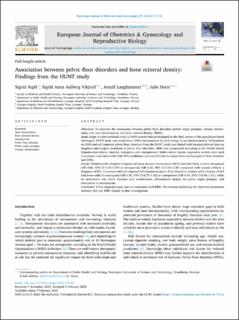| dc.contributor.author | Aspli, Sigrid | |
| dc.contributor.author | Vikjord, Sigrid Anna Aalberg | |
| dc.contributor.author | Langhammer, Arnulf | |
| dc.contributor.author | Horn, Julie | |
| dc.date.accessioned | 2023-05-11T09:26:57Z | |
| dc.date.available | 2023-05-11T09:26:57Z | |
| dc.date.created | 2022-04-27T12:36:32Z | |
| dc.date.issued | 2022 | |
| dc.identifier.citation | European Journal of Obstetrics, Gynecology, and Reproductive Biology. 2022, 271 71-76. | en_US |
| dc.identifier.issn | 0301-2115 | |
| dc.identifier.uri | https://hdl.handle.net/11250/3067631 | |
| dc.description.abstract | Objectives
To examine the association between pelvic floor disorders (pelvic organ prolapse, urinary incontinence and anal incontinence) and bone mineral density (BMD).
Study design: A cross-sectional study of 6809 women who participated in the third survey of the population-based Norwegian HUNT study was undertaken. BMD was measured by dual-energy X-ray absorptiometry. Information on BMD and self-reported pelvic floor disorders from the HUNT study was linked with hospital-derived data on diagnosis and surgical treatment of pelvic floor disorders. BMD was categorized according to the World Health Organization criteria (normal, osteopenia and osteoporosis). Multi-variate logistic regression models were used to estimate odds ratios (OR) with 95% confidence intervals (CI) for the association between pelvic floor disorders and BMD.
Results
Women with a hospital diagnosis of stress urinary incontinence (SUI) were less likely to have osteopenia (OR 0.66, 95% CI 0.50–0.87) or osteoporosis (OR 0.66, 95% CI 0.34–1.30) compared with women without a diagnosis of SUI. In women with self-reported information on pelvic floor disorders, women with a history of SUI had lower odds for osteopenia (OR 0.88, 95% CI 0.75–1.02) or osteoporosis (OR 0.69, 95% CI 0.46–1.01), while no association was found between anal incontinence, self-reported surgery for pelvic organ prolapse, and osteopenia or osteoporosis.
Conclusion
Pelvic organ prolapse was not associated with BMD. The reasons underlying the observed association between SUI and BMD require further investigation. | en_US |
| dc.language.iso | eng | en_US |
| dc.publisher | Elsevier | en_US |
| dc.rights | Navngivelse 4.0 Internasjonal | * |
| dc.rights.uri | http://creativecommons.org/licenses/by/4.0/deed.no | * |
| dc.title | Association between pelvic floor disorders and bone mineral density: Findings from the HUNT study | en_US |
| dc.title.alternative | Association between pelvic floor disorders and bone mineral density: Findings from the HUNT study | en_US |
| dc.type | Peer reviewed | en_US |
| dc.type | Journal article | en_US |
| dc.description.version | acceptedVersion | en_US |
| dc.source.pagenumber | 71-76 | en_US |
| dc.source.volume | 271 | en_US |
| dc.source.journal | European Journal of Obstetrics, Gynecology, and Reproductive Biology | en_US |
| dc.identifier.doi | 10.1016/j.ejogrb.2022.02.002 | |
| dc.identifier.cristin | 2019474 | |
| cristin.ispublished | true | |
| cristin.fulltext | postprint | |
| cristin.qualitycode | 1 | |

